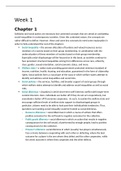Week 1
Chapter 1
Solidarity and social justice are necessary but contested concepts that are aimed at combatting
social inequalities in contemporary societies. Given this contested nature, the concepts are
rather difficult to define. However, these and some key concepts do need some explanation in
order to fully understand the rest of the chapters:
Social inequality = the uneven allocation of burdens and valued resources across
members of a society based on their group membership, in combination with the
undervaluation of these members of society based on their group membership.
Especially unfair disadvantage will be focused on in this book, as societies continue to
face persistent structural inequalities arising from differences across race, ethnicity,
class, gender, sexual orientation, social-economic status, and more.
Welfare state = a nation state providing government-protected minimum standard of
income, nutrition, health, housing, and education, guaranteed in the form of citizenship
rights. Social policies form a crucial part of the ways in which welfare states attempt to
identify and address social inequalities and social risks.
Social policies = the services, facilities, and broader support of social groups through
which welfare states attempt to identify and address social inequalities as well as social
risks.
Social dilemmas = situations in which short-term self-interests conflict with longer-term
societal interests. Here, individuals are better off if they do not act cooperatively, but
everybody is better off if everyone cooperates. As such, to sustain the welfare state and
encourage sufficient levels of welfare state support to disadvantaged groups in
particular, citizens need to be able to look past their individualistic tendencies. Thus,
questions surrounding social inequality could be framed as social dilemmas.
- Resource dilemmas = social dilemmas in which a course of actions that offers
positive outcomes for the self leads to negative outcomes for the collective.
- Public goods dilemma = social dilemma in which an action that results in negative
consequences for the self would, of performed by enough people, lead to positive
consequences for the collective.
- Prisoner’s dilemma: social dilemma in which (usually) two players simultaneously
face a choice between cooperating with each other or defecting, where the best
outcome for a player is the one where they defect and the other cooperates, while
the worst outcome is where they cooperate and the other defects.
, Self-transcending motives = solidarity and/or social justice motives that make someone
move past their self-interested behavioral tendencies.
Solidarity = about common identity, suggesting a mutual attachment between individual
in society, both practically (depending on each other) and normatively (what we expect
of each other). However, as the concept has historical roots in the concept of
brotherhood/fraternity, you should be aware that the meaning of solidarity is a subject
to change as societies evolve too, and also differ across contexts. Where social solidarity
is about having a common identity and a willingness to share resources, even across
group boundaries, social justice provides the rules through which people can do so.
Social justice = considerations about allocation: who is deserving of what, and how this
is to be achieved? A distinction can be made between distributive justice (what),
procedural justice (how), the scope of justice (by whom) and justice as recognition (for
whom).
Chapter 2
A deeper dive into Social identity theory is required to explain how social identities influence
people’s orientations toward certain groups, because social change often goes along with
indifference, resistance, and even hostility towards disadvantaged groups. In a nutshell, Social
identity theory proposes that a person’s self-concept is comprised of both personal identity
(unique attitudes, behaviors, memories and emotions) and social identities, which are defined
by the social categories and groups to which they belong, as well as the emotional and
evaluative consequences of this group membership. These social identities, in turn, influence
how they interact with and treat other people who have the same or different identities for
them.
How can social identities encourage intergroup animosity and resistance to social change?
Social identity salience = the extent to which people are thinking of themselves at
members of a group at one moment in time, and this influences how people interact
with each other. This is because when group memberships are salient, people are more
likely to make evaluative distinctions between their in-group and other out-groups,
which play a big role in the process of intergroup bias and animosity.
In-group favoritism and out-group derogation fulfill important identity functions for
group members. In-group favoritism = the tendency to favor in-group members over
the out-group in behavior, preferences, or perceptions, whereas out-group derogation
= unfavorable evaluations of out-groups and their members as a means of bolstering the
ingroup’s status or image (e.g., intergroup discrimination). Certain threats increase the
likelihood of social animosity:






